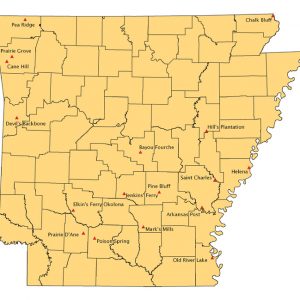calsfoundation@cals.org
Skirmish at Pine Bluff (June 17, 1864)
aka: Skirmish at Monticello Road (June 17, 1864)
|
Location: |
|
|
Campaign: |
None |
|
Date: |
June 17, 1864 |
|
Principal Commanders: |
Lieutenant Colonel Wilton Jenkins (US); Unknown (CS) |
|
Forces Engaged: |
Fifth Kansas Cavalry (US); Unknown (CS) |
|
Estimated Casualties: |
2–3 wounded (US); Unknown (CS) |
|
Result: |
Union victory |
A brief encounter between forces near Pine Bluff (Jefferson County), this skirmish is typical of the majority of fighting in the state. Two patrols from opposing forces brushed against one another in an effort to gain intelligence, leading to a short fight.
Colonel Powell Clayton of the Fifth Kansas Cavalry commanded the Union post of Pine Bluff and regularly sent out patrols to gather information about Confederate movements in the area. Three patrols returned to Pine Bluff on June 16, 1864, one of which reported a Confederate cavalry brigade camped near “Connersville” (probably Cornersville in Lincoln County) and enemy pickets watching the road to Monticello (Drew County). These were the only Confederate forces reportedly in the area. One of the patrols also captured a dispatch rider carrying information about Confederate troop placements in the area. According to the messages the rider carried, every road in the area was covered by Confederate pickets.
At 1:30 the next afternoon, a large Confederate force approached the Union lines, making an attack along the Monticello road. The Federal pickets fell back to the main line, and a heavy skirmish continued until troops under the command of Lieutenant Colonel Wilton Jenkins forced the Confederates back. Retreating back down the Monticello road, the Confederates were pursued by Jenkins and his men for several miles. According to reports, the Confederates suffered several dead and wounded, but exact figures are not available.
While the Federals under the command of Jenkins continued to pursue the retreating Confederates, another Union unit under the command of Lieutenant William Grove of the Seventh Missouri Cavalry approached the campsite that had been located the day before. Estimating that the camp housed approximately 700 enemy horsemen and that its occupants were the force currently engaging the other Union force, the Federals destroyed it.
Although it was only a minor engagement with few casualties, this skirmish showed how effective Union patrolling and information gathering could be outside of Federal strongholds. Without the report of the patrol on June 16, the Union forces would have been surprised. Instead, through effective planning and operations, the Confederates were not only repulsed, but their camp was destroyed.
For additional information:
The War of the Rebellion: A Compilation of the Official Records of the Union and Confederate Armies. Series 1, Vol. 34. Washington DC: Government Printing Office, 1889.
David Sesser
Henderson State University
 ACWSC Logo
ACWSC Logo  Civil War Events Map
Civil War Events Map 



Comments
No comments on this entry yet.